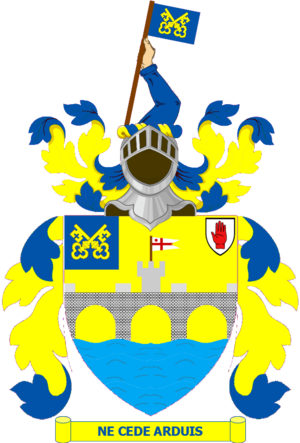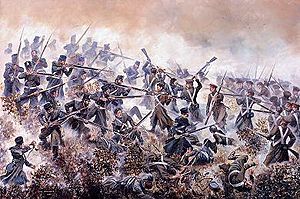Sir Thomas Troubridge, 3rd Baronet facts for kids
Quick facts for kids
Sir Thomas Troubridge
|
|
|---|---|
 |
|
| Born | 25 May 1815 |
| Died | 2 October 1867 Queen's Gate, Hyde Park, Kensington |
| Buried |
Kensal Green Cemetery
|
| Allegiance | |
| Service/ |
British Army |
| Rank | Brevet Colonel |
| Commands held | 7th (Royal Fusiliers) Regiment of Foot |
| Battles/wars | Crimean War |
| Awards | Companion of the Order of the Bath Order of the Medjidie (fourth class) Légion d'honneur |
| Relations | Sir Edward Thomas Troubridge (father) Ernest Troubridge (son) |
Sir Thomas Troubridge was a brave officer in the British Army. He is remembered for his courage during the Crimean War. He was born into a family with a long history of serving in the military. Both of his grandfathers and his father were admirals in the Royal Navy.
Thomas joined the army and quickly moved up in rank. He served in different places across the British Empire. In 1852, he became the 3rd Baronet after his father passed away. When the Crimean War started in 1854, he was a major. He fought in important battles like the Battle of Alma and the Battle of Inkerman. During the Battle of Inkerman, he was badly hurt, losing his right leg and left foot. Even with his serious injuries, he refused to leave the fight until the enemy was pushed back. His bravery was highly praised by his commanding officer.
After returning to Britain, he received many awards and promotions. His injuries meant he could not fight on the front lines anymore. However, he continued to serve the army by helping with supplies and logistics until he passed away in 1867.
Contents
Early Life and Joining the Army
Thomas Troubridge was born on May 25, 1815. He was the oldest son of Admiral Sir Edward Troubridge, 2nd Baronet. His mother, Anna Maria, was also the daughter of a naval officer.
Thomas went to the Royal Military College, Sandhurst. This is a famous place where army officers are trained. He joined the army as an ensign, which is a junior officer rank, in 1834. He later became a lieutenant in the Royal Fusiliers in 1836.
He served with his regiment in many parts of the British Empire. These places included Gibraltar, the West Indies, and Canada. He continued to earn promotions, becoming a captain in 1841 and a major in 1850.
Heroism in the Crimean War

When the Crimean War began in 1854, Major Troubridge went with his regiment to the Crimea. He fought in several major battles. These included the Battle of Alma, the operations around the Siege of Sevastopol, and the Battle of Inkerman.
At the Battle of Alma, he led the right side of his regiment, the Royal Fusiliers. He bravely led his soldiers forward under heavy enemy fire. They attacked the enemy's strong positions on the heights.
He continued to serve with the Royal Fusiliers during the long Siege of Sevastopol. Then, on November 5, 1854, he fought in the Battle of Inkerman. During this battle, Russian troops attacked his position. The fighting was very fierce. Troubridge was hit by a shot that caused him to lose his right leg and left foot.
Despite his terrible injuries, he refused to leave his post. He stayed there for two more hours, even propping up his injured limbs to stop the bleeding. He did not leave until the Russian attack was defeated. After the battle ended, he was finally taken to the hospital. His commanding officer, Lord Raglan, praised his "utmost gallantry and composure" in official reports.
Life After the War
Because of his bravery, Thomas Troubridge was promoted to lieutenant colonel in December 1854. However, his injuries meant he could not return to active fighting. In May 1855, he was sent home.
He attended a special ceremony where Queen Victoria gave out medals. He was made an aide-de-camp to the Queen, which is a special assistant role. He also received the Companion of the Order of the Bath award. Other countries that were allies with Britain in the war also honored him. France gave him the Légion d'honneur, and the Ottoman Empire gave him the Order of the Medjidie.
Even though he couldn't fight, Troubridge remained active in the army. He became the director-general of army clothing in 1855. He even designed a new type of military backpack, called a valise. His design was very successful and helped improve equipment for soldiers in the future.
Family Life and Passing Away
Sir Thomas Troubridge married Louisa Jane Gurney in November 1855. They had three sons and four daughters. One of their sons, Ernest Troubridge, also became a famous naval officer.
Louisa Troubridge passed away in August 1867. Sir Thomas died five weeks later, on October 2, 1867, at his home in Kensington, London. He was 52 years old. He was buried in Kensal Green Cemetery. His oldest son, Thomas Herbert Cochrane Troubridge, became the next Baronet.

